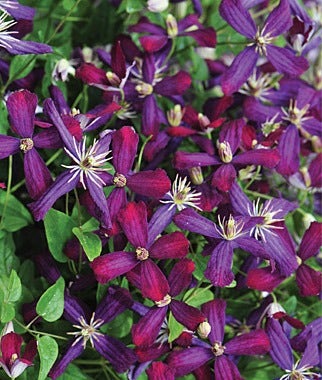We use cookies to give you the best experience on our website. These cookies are completely safe and secure and will never contain any sensitive information. Please read our Privacy Policy. By clicking "Ok" or clicking on any other content, you agree that cookies can be placed.
Clematis
Clematis are magnificent flowering vines. They’re the original front-yard vine, often planted at the base of a lamp-post by the front walk to mark the home of a dedicated gardener with profuse bloom.
Gardeners have admired and grown clematis since at least the 16th century, and more than 2,500 hybrids have been developed. They thrive in sunny gardens, although pale-flowered varieties, such as ‘Will Goodwin,’ are usually happiest in bright shade. Where summers are very hot, morning sun or bright, indirect light is the best choice. Plant them in loamy, well-drained soil enriched with compost. Some gardeners shade their plants at the roots with a broken terra-cotta pot; compost around the base accomplishes the same purpose: it helps prevent moisture loss from the soil and moderates the soil temperature.
Clematis with great big flowers, up to nine inches across, are perhaps the most popular varieties. The splashy ‘Henryi’ will attract lots of attention with its enormous snow-white blooms; the handsome ‘Jackmani’ is equally dramatic, with velvety purple flowers. ‘Pink Fantasy’ and ‘Angela’ are both known for their compact habit, growing only 6-7 feet tall; their charming flowers are four inches across.
Although they are often trained along a fence rail or up a post by themselves, clematis will grow gracefully up through shrubs and roses. Some gardeners plant a clematis every time they plant a rose — in the same hole. Around established roses, set clematis plants a foot or two from the crowns and train them onto the roses. Clematis will also clamber up through hydrangea, abelia, weigela, and other shrubs.
When you plant, dig a big hole, at least one foot wide and deep, to create the well-drained soil these flowers thrive in. Set the plant in the hole with its crown three to five inches below soil level, place a supporting stake close to the crown, and then fill in and water well. While the plant becomes established, you may need to water every other day. Keep the area around the roots covered with a two- to four-inch layer of mulch (compost or crushed leaves work fine).
Clematis vines bloom with such exuberance that they practically hide the plants' foliage. The bloom may last up to four weeks. In a garden with a good variety of clematis, the blooming season may extend from spring through fall. It’s a lively show: enjoy the flowers in the garden and cut some for the house, too. Snip the flowers when they’re almost open, and you can watch them unfold in a vase on your desk.

